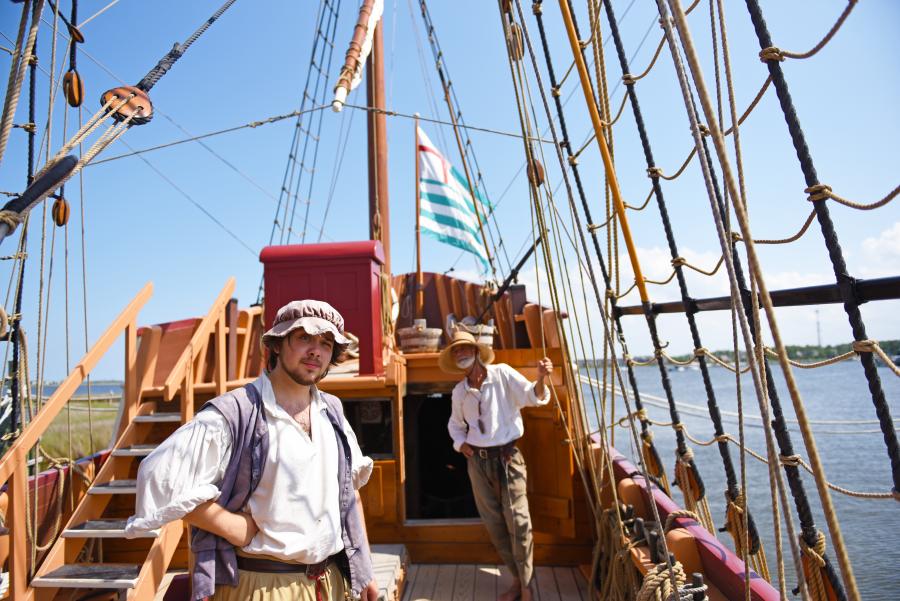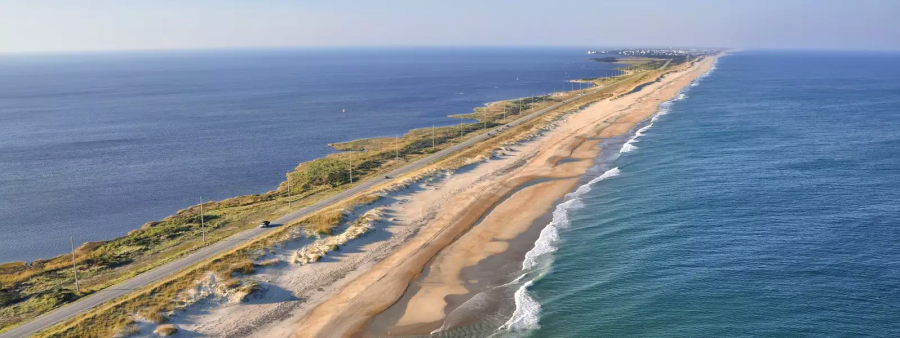You're never far from history on the Outer Banks. Check out these fun and interesting facts about the Outer Banks before you visit.
Northern Beaches

-
On December 17, 1903, two brothers, Orville and Wilbur Wright, made the first successful flights in motor-driven, heavier-than-air machines, thus ushering in the age of human flight. These historical flights took place on the sloping sands of what is now known as Big Kill Devil Hill, located just south of Kitty Hawk.
-
The Nags Head Woods Preserve is considered one of the best remaining examples of a mid-Atlantic maritime forest, according to the Nature Conservancy organization. The habitat is made up of 640 acres of protected wetland, dune and hardwood forest and is a national natural landmark.
-
Jockey's Ridge State Park, located in Nags Head, is the home of the highest sand dune on the East Coast with peaks at more than 90 feet.
-
Dare County covers 800 square miles, comprising 391 square miles of land and 409 square miles of water.
-
According to the International Gamefish Association, the Outer Banks and the Virgin Islands are the most likely places to catch Atlantic Blue Marlin weighing more than 1,000 pounds.
-
The OBX is home to 5 different types of sea turtles that visit for mating, nesting, and resting.
-
The Mountain-to-Sea Trail stretches 1,175 miles across the state of North Carolian, from the Great Smoky Mountains to the top of Jockey's Ridge.
-
The Outer Banks Scenic Byway is one of three national scenic byways in North Carolina, recognized for its cultural contributions to our state heritage and identity alongside the unencumbered natural beauty and pristine setting.
Roanoke Island & Dare Mainland

-
The first English child born in the New World was Virginia Dare on August 18, 1587, at Fort Raleigh on Roanoke Island. Virginia Dare and the colonists of Fort Raleigh would become known as "The Lost Colony"...their disappearance still an unsolved mystery. The Elizabeth II ship at Roanoke Island is a replica of one of the seven vessels used during the Roanoke voyages.
-
"The Lost Colony," performed at the Waterside Theater on Roanoke Island, is the oldest-running outdoor symphonic drama in the country. The streets in downtown Manteo were renamed for Lost Colony members (real and fictional).
-
Alligator River National Wildlife Refuge covers 237 square miles (615 sq km) and is one of the more exceptional settings for wildlife viewing in the Outer Banks and the country. This natural area is home to a program to reintroduce the endangered Red Wolf into the wild. It’s also the northernmost habitat for the American Alligator. You may be surprised to find that the highest concentration of Black Bears in the country and the largest of that species are in the refuge.
-
Roanoke Island is home to an eleventh generation family. Island Farm is a living history site interpreting their daily life on Roanoke Island in the mid-1800s. Living on the bounty of the surrounding waters while working the land to feed their families, islanders were independent and enterprising.
-
Near the center of Roanoke Island you’ll find The Mothervine – the oldest cultivated grapevine in the U.S. Now grapevines aren’t much to look at- they’re gnarled, barky things. Growing here since around 1584, this muscadine vine stands in the front yard of a home and an extensive set of trellises support its thick, heavy trunk and what looks like a quarter-acre of vines and leaves. There’s no wine made from The Mothervine’s grapes, instead it’s all alcohol-free juice, but that juice is packed in antioxidants and with just a sip you can say you have a tie back to the very roots of our nation.
-
The OBX has influenced countless stories told through television, film, radio, books & more. Nights in Rodanthe, Netflix's "Outer Banks," The Peanut Butter Falcon to name a few. Check out these other locally filmed productions.
Hatteras Island

-
The Cape Hatteras National Seashore, encompassing more than 28,000 acres along the Outer Banks, was the first to be established by our government. The purpose was to preserve this beautiful shoreline for the enjoyment of future generations.
-
Richard Etheridge became America's first black lifesaving station keeper with his appointment to the Pea Island post in 1880. He served as keeper until his death in 1900. He was a former soldier and surfman. Follow along the African American Experience of Northeast North Carolina.
-
The Cape Hatteras Lighthouse, which stands at 208-feet, is the tallest brick lighthouse in the United States.
-
The Graveyard of the Atlantic is home to estimates approaching 3,000 shipwrecks along the islands, going back to the first English settlements in America. Check out these 5 Shipwrecks
-
The War Between the States brought several battles to the Outer Banks. At Hatteras Inlet (August, 1861), at Chicamacomico (October 1861) and on Roanoke Island (February 1862), the Federals won their first victories of the war and established control over the Outer Banks. The inhabitants were not strongly attached to the Southern cause, and many took the oath of allegiance to the United States.
-
More than 400 species of birds have been identified at the Pea Island National Wildlife Refuge, located on the north end of Hatteras Island.
-
In 1902, Reginald Fessenden made the first application of a successful, commercially adaptable technique of radio communications in North America and perhaps the entire world. His experiments and invention of the wireless telegraph and telephone were made between a station located on Roanoke Island and a section station in Buxton. After leaving North Carolina, Fessenden went on to establish the first commercial Trans-Atlantic two-way radio-telegraph service in 1905, two years before the world renowned Marconi. Then, in 1906, Fessenden's station in Massachusetts broadcasted the world's first radio program for entertainment.
-
In 1874, the U.S. Lifesaving Service was begun by building a chain of seven lifesaving stations along the Outer Banks, at the points of greatest danger to ocean going vessels. The U.S. Lifesaving Service was the forerunner to the U.S. Coast Guard. The lifesaving stations, working in conjunction with the several lighthouses located along the Outer Banks, helped to save and rescue many vessels as they passed through the Graveyard of the Atlantic.
-
Opened on January 1, 1902, the U.S. Weather Bureau Station Hatteras Welcome Center played a key role in the nation’s developing meteorological network, until decommissioned in 1946. Today it is operated by the Outer Banks Visitors Bureau in partnership with the National Park Service as an historical site as well as information center. Hatteras is the only known wireless station in the United States to have received the first distress call from the Titanic.
Neighboring Areas
-
On November 22, 1718, Edward Teach, better known as Blackbeard the pirate, was slain by Lt. Robert Maynard of the Royal Navy, in Ocracoke Inlet.
-
The oldest and shortest lighthouse in North Carolina is the Ocracoke Lighthouse. It's the second oldest operational lighthouse in the United States.
-
Possibly the oldest residents of Corolla, the wild Spanish Mustangs are unique to Currituck county. They can be viewed in the 4x4 beaches in northern Corolla.

